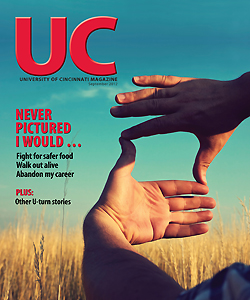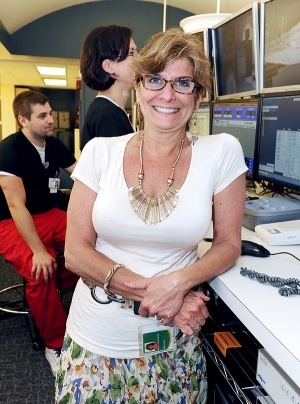UC grad's career moved from corporate world to waiting tables to treating cancer
by Amanda Harper
Ruth knew from the age of 2 that she wanted to be a doctor.
It just took her 30 years to realize medicine was the right path for her. Now 52 -- and seven years into her career as a radiation oncologist specializing in breast and pediatric cancer -- Ruth Lavigne, MD '00, says being a doctor feels like a "comfortable old shoe."
"It was just sitting there waiting for me to slip my foot into it all my life," she adds.
The journey toward medicine
Lavigne remembers the moment she realized something needed to change in her life. She was 32 -- a mother of two small children -- working as a waitress in San Diego.
"I was holding tiny little Arielle looking into her face thinking she was so beautiful and perfect. I wanted my daughter to know she could be anything she wanted to be," recalls Lavigne, cradling her arms as if once again holding her baby.
"And then I realized that one day she would be smart enough to say to me: 'Oh, you wanted to be a waitress? Got it.' That's when I decided I needed to walk the walk."
Her path to medicine was not straight -- it zigzagged through various cities and industries until she got on what felt like the right course when she entered the University of Cincinnati College of Medicine in 1996.
Lavigne graduated with a master's degree in international business from the American Graduate School of International Management in 1982 and began her career as a broker with a money management company. She quickly realized the corporate world wasn't for her. She hated the office life, so when she moved to San Diego with her husband and their growing family in 1985, she decided to become a banquet waitress.
"For a while, I loved it because it gave me the flexibility to take care of my kids. It was such a great change of pace from the corporate world," she says.
The idea of going into medicine came and went in the back of her mind. But she felt that ship had sailed. It would take more than a decade of additional education to become a doctor, and she had too many responsibilities: two kids to care for, a husband, bills to pay.
"Eventually, I thought, 'Why can't I be a doctor?' That is when all the stars began to align for me to pursue my dream. It certainly felt like a dream be-cause it seemed impossible to achieve at the time."
Lavigne sought the advice and help of her father, Myron Moskowitz, A&S '54, MD '58, a radiologist who was practicing at what is now UC Health University Hospital as part of the UC College of Medicine faculty. Her mother-in-law offered to babysit.
Lavigne spent the next four years taking medical school prerequisite classes in San Diego during the day while continuing to waitress in the evenings, squeezing in precious time with her kids in between. At age 36, she packed up and moved cross-country to Ohio with her husband and two children, then ages 5 and 6.
She chose UC for medical school because it was the most welcoming of nontraditional students, she says. After all, she was a 36-year-old married mom in a class of mostly 22-year-olds. In addition, her father committed to keep working as a radiologist in order to offset half of her medical education tuition costs.
"Everyone at UC was very positive and supportive during my interviews. It just felt like a very good fit for me and my needs," Lavigne says. "Moving to Cincinnati was the start of a new chapter in my life."
Med school at age 36
Lavigne laughs that it "took a village" to facilitate her entry back into school to tackle the 14-year education climb required to become a doctor. Balancing the transition -- and sustaining it -- was no easy feat.
"It was tough. When I was at home with my kids, I felt like I should be studying. When I was at school or work, I felt like I should be home. You are always fractionated," she recalls.
Being a non-traditional student did have some advantages, though. Entering medical school at 36 instead of 22, she had the benefit of perspective. Time was her biggest challenge. She didn't have the luxury of downtime, but that gave her steely-eyed determination and focus. She carefully managed her time, resources and priorities to make it all work.
"I loved what I was doing and learning, so I never had to force myself to study. It was just finding the time to do it.
"Sometimes that meant waking up at 1 a.m. and studying while the kids were asleep. Sometimes it was just that I went to every single class and took careful notes because I knew I wouldn't have much time to revisit the material.
"Once I took the leap of faith, though, I was committed. My journey to become a doctor took 14 years. But I made it. And I feel good deep down that I set a positive example for my children," Lavigne adds.
Her daughter, Arielle, is now a senior at UC studying history and intends to pursue a master's in library science. Her son, Ryan, is about to enter his junior year at Appalachian State in North Carolina and plans to attend law school.
Choosing oncology
Now working at Christ Hospital, Lavigne credits the mentorship of William Barrett, MD '87 -- current chair of the UC College of Medicine Department of Radiation Oncology and her former colleague within UC Health's radiation oncology team -- for cementing her decision to be an oncologist. "He gave me enormous motivation. I looked up to him and wanted to emulate him," she says.
Lavigne's mother had been a social worker in his department. Her father had worked with Barrett's father years ago, so she had always heard good things about the oncologist.
"In the summer between my first and second years of medical school, I did an oncology rotation. I'd go in with Dr. Barrett to see patients, and I thought, 'This is the type of doctor I want to be.' Before that, I thought I would go into radiology, but after watching him I realized I needed that personal connection with patients, too.
"That is why I love what I do. Every day, I get to help people."
Link:
UC College of Medicine

 Past Issues
Past Issues